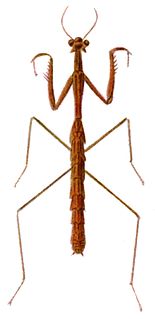
Mantis shrimps, or stomatopods, are marine crustaceans of the order Stomatopoda. Some species have specialised calcified "clubs" that can strike with great power, while others have sharp forelimbs used to capture prey. They branched from other members of the class Malacostraca around 400 million years ago. Mantis shrimps typically grow to around 10 cm (3.9 in) in length. A few can reach up to 38 cm (15 in). The largest mantis shrimp ever caught had a length of 46 cm (18 in) and was caught in the Indian River near Fort Pierce, Florida, in the United States. A mantis shrimp's carapace covers only the rear part of the head and the first four segments of the thorax. Varieties range from shades of brown to vivid colors, as more than 450 species of mantis shrimps are known. They are among the most important predators in many shallow, tropical and subtropical marine habitats. However, despite being common, they are poorly understood, as many species spend most of their lives tucked away in burrows and holes.

The Chinese mantis is a species of praying mantis native to Asia and the nearby islands. In 1896 this species was accidentally introduced by a nurseryman at Mt. Airy near Philadelphia, United States. Tenodera sinensis often is erroneously referred to as Tenodera aridifolia sinensis because it was at first described as a subspecies of Tenodera aridifolia, but Tenodera sinensis is now established as a full species.

Mantidae is the largest family of the order Mantodea, commonly known as praying mantises; most are tropical or subtropical. Historically, this was the only family in the order, and many references still use the term "mantid" to refer to any mantis. Technically, however, "mantid" refers only to members of the family Mantidae, and not the 14 remaining families of mantises. Some of the most recent classifications have promoted a number of the mantid subfamilies to the rank of family, e.g. Iridopterygidae, Sibyllidae, Tarachodidae, Thespidae, and Toxoderidae, while other classifications have reduced the number of subfamilies without elevating to higher rank.

Mantinae is a subfamily of mantis of the family Mantidae. It was authored by Hermann Burmeister in 1938.

Flower mantises are those species of praying mantis that mimic flowers. Their coloration is an example of aggressive mimicry, a form of camouflage in which a predator's colours and patterns lure prey. Most species of flower mantis are in the family Hymenopodidae. Their behaviour varies, but typically involves climbing a plant, and then staying still until a prey insect comes within range. Many species of flower mantis are popular as pets.

Archimantis latistyla, commonly known as the large brown mantis is a species of mantid native to Australia. The large brown mantis has two subspecies, a widespread subspecies and the stick mantis ghost from Bundabergs Turtle Sands. The stick mantis ghosts are not as aggressive as the widespread species but have a defense display used to make the mantis appear larger by flinging its front legs into the air and putting its head down along with its antennae. Large brown mantids are light brown with short winged female and a long winged male. The subspecies from Bundaberg is a pale cream white with a yellow and black eye in between the arms. The large brown mantis female is short winged - her wings reach only half her abdomen and she is not able to fly—but the long winged male has wings that cover the entire abdomen. They have two pairs of wings - the top pair are the wing covers and the bottom wings enable the mantis to fly.

Archimantis monstrosa is 1 of 10 species in the genus Archimantis. A. monstrosa, or Monster Mantis, commonly reaching a length of 90mm or more. It is less common than the often-seen Large-Brown Mantis. A. monstrosa living near the coast can get quite large and sometimes will attack much larger prey.

Stick mantis and twig mantis are common names applied to numerous species of mantis that mimic sticks or twigs as camouflage. Often the name serves to identify entire genera such as is the case with:
Archimantis armata is a species of praying mantis in the genus Archimantis in the order Mantodea.
Archimantis brunneriana is a species of praying mantis in the genus Archimantis in the order Mantodea.
Archimantis gracilis is a species of praying mantis in the genus Archimantis in the order Mantodea.
Archimantis quinquelobata is a species of praying mantis in the genus Archimantis in the order Mantodea.
Archimantis sobrina is a species of praying mantis in the genus Archimantis in the order Mantodea.
Archimantis straminea is a species of praying mantis in the genus Archimantis in the order Mantodea.
A. gracilis may refer to:

Mantises are an order (Mantodea) of insects that contains over 2,400 species in about 430 genera in 15 families. The largest family is the Mantidae ("mantids"). Mantises are distributed worldwide in temperate and tropical habitats. They have triangular heads with bulging eyes supported on flexible necks. Their elongated bodies may or may not have wings, but all Mantodea have forelegs that are greatly enlarged and adapted for catching and gripping prey; their upright posture, while remaining stationary with forearms folded, has led to the common name praying mantis.
Epaphroditini is a tribe of the family Hymenopodidae. It has the following members:









